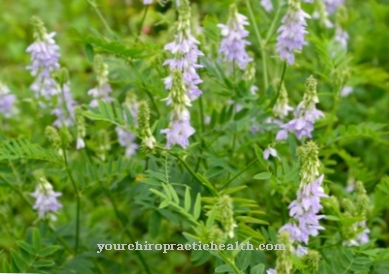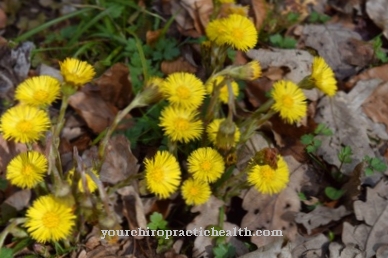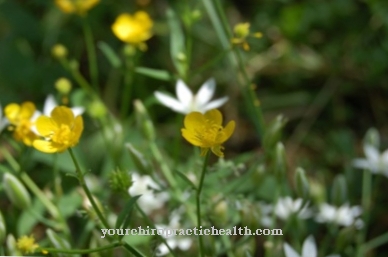The Blueberry Can hardly be surpassed in diversity: Not only in the domestic kitchen it is part of the preparation of various dishes, but also in naturopathy it has been a fixture for centuries. The American natives already worshiped the blueberry as a medicinal plant and used the fruit to treat various ailments.
Occurrence and cultivation of the blueberry

This also applies today Blueberry still as an all-rounder in natural medicine: it is used for gastrointestinal diseases, has a preventive effect against civilization diseases such as cancer or diabetes and is considered a natural anti-aging agent that slows down the external and internal aging of the human body. The blueberry is also a popular fruit on the menu of dieters, as it is not only absolutely low in calories, but also supports the process of losing weight through various ingredients.
The blueberry, popularly also called Blueberry, Mollberry, Wild berry or Blackberry is a species from the heather family. However, the commercially available cultivated blueberries are a type of the American blueberry and not from that native to Europe. The blueberry is found in all Nordic and temperate climates in Europe and Asia.
It prefers a soil that is poor in base and nutrients, which the penumbra can find in deciduous and coniferous forests, especially in pine and mountain spruce forests, as well as in mountain and moorland landscapes. The blueberry is deep-rooted, so it develops roots of up to one meter and feeds on raw humus with the help of root fungi.
The heather plant is very sensitive to frost: even late frosts can cause considerable damage; in severe frosts, the plant usually freezes completely. In this case the rootstock remains intact and can sprout again in spring.
Effect & application
The bilberry is used as a medicinal plant in a variety of ways: its dried, fresh or frozen fruits are used to treat all symptoms and ailments, the type of intake ranges from the natural berry in its raw state to pharmaceutical preparations. The blueberry contains a large number of different ingredients that have a positive effect on the human organism or can promote healing in specific diseases.
The fruit of the blueberry mainly contains secondary plant substances such as anthocyanidins, catechin tannins, flavonoids, proanthocyanidins, fruit acids, pectins and invert sugar. Phenol carboxylic acids, arbutin, hydroquinone, tannins, quinolizidine alkaloids as well as chromium and manganese are mainly found in the leaves of the plant. The area of application of the individual active ingredients is broad and begins with digestion.
Due to their high tannin content and high concentration of pectins, dried blueberries are an effective remedy for diarrhea, while consuming larger quantities of fresh fruit has a laxative effect and is therefore often used as a natural remedy for constipation. Blueberries also have anti-inflammatory effects, which is why the juice of the fruit can be used as a gargle for mild inflammation in the mouth or throat.
The anthocyanidins contained in the berries also have a regenerating effect in the case of illness-related fragility of the capillary systems - they stabilize them and thus counteract the accompanying symptoms of various diseases such as diabetes. But blueberries are also used for gastrointestinal ulcers, diseases of the retina or impaired vision at dusk or at night, mostly in the form of ready-made preparations.
The preparation and use of blueberry leaves is controversial. Although these are considered to lower blood sugar due to their high chromium content, they can cause symptoms of poisoning when consumed for a long time, which is why the possible medical usability of the leaves of the blueberry is still unclear.
Importance for health, treatment & prevention
But the blueberry can not only be used to treat acute complaints, but also has a strong preventive effect. In most cases, regular consumption of the fruit helps to effectively prevent diseases and also supports the adequate supply of nutrients to the human body. In addition to secondary substances, the blueberry also contains a large number of vital primary plant substances that the human organism must supply through daily food intake. In particular, their high levels of iron, folic acid and zinc have a positive effect on blood sugar levels and strengthen the immune system.
Thanks to its vitamin C and a variety of fiber, the blueberry also helps you lose weight; Their high potassium content also boosts fat metabolism. In addition, with a calorific value of around 43 kcal per 100 g, the berry is extremely low in calories, making it one of the most figure-friendly types of fruit. Similar to the related strawberry, blackberry and raspberry, it contains many carotenoids that - especially beta-carotene - support human vision and prevent age-related visual impairments.
The pterostilbene in blueberries also have a very positive effect - they lower the cholesterol level. In addition, the blueberry is considered to be a preventive measure against one of the most widespread diseases of civilization: cancer. Cancer is caused by a preponderance of free radicals, which damage cells and, in the worst case, can lead to the formation of tumors that metastasize in the body.
Free radicals are also responsible for the visible aging of our skin and can also promote inflammatory processes. The polyphenols contained in high concentrations in blueberries trap free radicals, and the tannins in the fruit, especially hydroxycinnamic acid, have an additional anti-inflammatory effect. Blueberries not only prevent cancer, they also slow down the aging process, protect blood vessels and prevent diseases of the cardiovascular system.

























.jpg)


